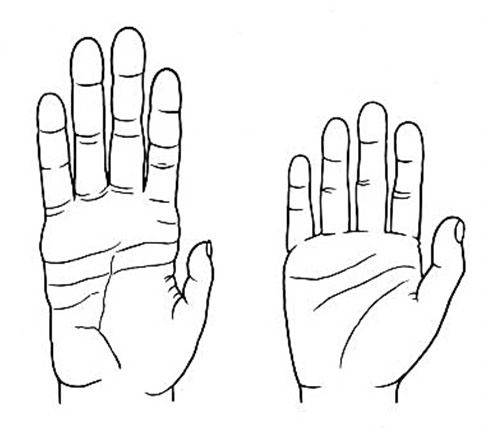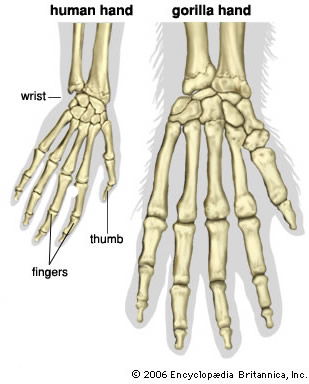
Are Human Hands More Primitive Than Chimps’?
News to Know
Abstract
With a classic Planet of the Apes twist on evolutionary thinking, the latest research on hands would suggest to the chimpanzee Dr. Zira that she has a bit of primitive human in her past.
News Sources
- Science: “Humans Have More Primitive Hands Than Chimpanzees”
- Nature World Report: “Chimps vs Humans—Whose Hands Are More Primitive?”
Thumbing through the pages of most manuals on human evolutionary history, a reader would soon latch onto the idea that our precision grip was a relatively recent addition to the human repertoire. Evolutionary researcher Sergio Almécija and colleagues have knocked the pins from under that bit of conventional evolutionary thinking. They are challenging the view that humans diverged from chimp-like ancestors with hands adapted to swing from tree limbs. They believe the human hand’s precision grip is not advanced but instead represents the primitive condition much like that of the last common ancestor shared with apes.
Getting a Grip on Human Origins
“Human hands have not changed that much since they diverged from chimpanzees,” Almécija says. “Chimpanzees have actually evolved more than humans.”1
Evolutionary wisdom holds that humans developed big brains and creative powers after coming down from the trees and evolving hands capable of manipulating the world around them. Such manual dexterity presumably gave our ancestors something to think about and made the manufacture of tools move past the fashioning of stone axes so they could adapt and evolve to hoist themselves into the modern world. Almécija’s analysis of primate thumb-and-finger proportions published in Nature Communications overturns the view that we humans evolved our hands from chimp-like ancestors in favor of the notion that chimps evolved their hands from hands like ours.
The Shape of Your Pincer Grip
Your human ability to nimbly hold and manipulate objects between your thumb and any one of your fingers depends on more than the ideally designed proportions of your thumb, finger, and hand bones. Each curve in the contour of the bone at the end of the thumb (pollical distal phalanx) enhances the human ability to feel and grip tiny objects gingerly but securely. As shown above, the tendon (shown in red) that enables you to freely flex the end of your thumb is accommodated by a particularly large depression (in orange, proximopalmar fossa). Just beyond this tendon’s insertion, an especially large depression (in green) accommodates the bulky soft tissue of the thumb pad (proximal ungual pulp), which is soft and mobile enough to adapt to the shape of an object being grasped. And beyond that is another more shallow depression (in blue) for the soft tissue of the thumb’s tip (distal ungula pulp), which being smaller and less mobile is able to securely grasp a tiny object.

Image by Sergio Almécija, Salvador Moyà-Solà, and David Alba, via PLoS ONE.2
Living great apes like chimpanzees and gorillas do not have these bony contours. They can only manipulate small objects by gripping them between the thumb and index finger tip-to-tip or pad-to-side, a pad-to-pad grip being impossible for them. Australopithecines also lack these grip-enhancing contours.3 Interestingly, the thumb bone from Orrorin tugenesis—an incomplete collection of human-like bones and teeth that evolutionists date at 5.7 to 6.1 million years—does have these typically human curves.4 The identity of Orrorin’s very fragmentary skeleton and its possible relationship to Homo remains in dispute but would never be considered Homo as evolutionary dogma could never accommodate the existence of a human alleged to be 3 million years older than australopithecine apes.5 Given the appearance of this shape in a thumb bone dated so very early in the ape-like hominid-to-human evolutionary tale, Almécija has maintained since 20106 that the human grip is a primitive feature that long preceded the mental capacity to make tools.7
The Better to Swing from Trees, My Dear . . .
With longer thumbs and shorter fingers in addition to their unique bony contours, human hands differ markedly from those of long-fingered monkeys and arboreal apes like chimpanzees and orangutans.8 But which bony proportions came first? What was the hand of the evolutionary common ancestor of humans and apes like? That’s the question Sergio Almécija and colleagues have tried to answer in their study recently published in Nature Communications.

The chimpanzee’s hand (left) has much longer fingers, a longer palm, and a shorter thumb than the human hand (right). Unlike the chimp’s hand, the uniquely designed human hand has a fully opposable thumb and is able to clench into a tight fist. The design of the chimpanzee’s hand is far more suitable than a human’s for swinging through trees. Image by Denise Morgan for the University of Utah, via Wikimedia Commons.
The authors write that the present-day ape-human distinctive “fails to provide an adequate framework for testing competing hypotheses of human evolution and for reconstructing the morphology of the last common ancestor (LCA) of humans and chimpanzees.”9 Therefore they look to the past. They examine the hands of modern and extinct varieties of humans (like Neanderthals) as well as extinct apes, such as Ardipithecus ramidus and Australopithecus sediba, believed by evolutionists to be evolutionarily related to humans. They say that their study is “phylogenetically informed.” In other words, they assume humans and apes evolved from a common ancestor and, by tracing the hand through that assumed evolutionary history, they have determined what that hypothetical ancestor’s hand looked like.
For starters, the authors tried to nail down just what defines the differences between ape and human hands, mathematically speaking. They explain the subtle nature of this question, writing, “IHPs [intrinsic hand proportions] provide limited information regarding what distinguishes humans from apes: is it a longer thumb, shorter digits or a combination of both?”10 They standardized all their measurements in relation to body size, among other things.
Once they tried to match their results to the evolutionary tree of life, however, they discovered a “complex pattern” that made it impossible to trace trends in hand development across evolutionary history. Even though australopithecine apes had somewhat longer thumbs than living apes, they admit, “Our results reveal high levels of hand disparity among modern hominoids, which are explained by different evolutionary processes.”11

Like the thumb of Ardipithecus ramidus, the thumb on this Australopithecus sediba’s hand is disproportionately long when compared to a chimpanzee’s. Although that makes it slightly closer to human proportions, paleoanthropologist William Jungers, coauthor of the current study in Nature Communications, does not think this australopithecine hand could have managed an advanced precision grip or manipulated objects like a human hand.12 These australopithecines are extinct apes, and, like the hand variations among living apes, their variable hand anatomy is indicative of primate diversity, not evolutionary lineage. Nevertheless, the recent study discussed here has re-defined the long-thumb of the human hand as a primitive feature. (Read more about Australopithecus sediba’s hand at “Sediba with a Little Sleight of Hand.”) Image copyright AP, via The Daily Mail.13
Nevertheless, Almécija’s team decided that both ancient and modern human hand proportions match up best with the most primitive members of the anthropoid evolutionary tree. While other researchers have suggested humans evolved their precision grips early, Almécija’s team classifies human hand proportions as primitive and believes arboreal adaptations evolved from them.
The Gorilla Connection
The authors conclude that human and gorilla hands resemble those of a hypothetical ground-based ancestor shared by all apes and humans. Monkeys, chimps, and orangutans, therefore, must have evolved longer fingers to better swing from trees. Humans and gorillas handily stacked up as the least evolved of modern primates, presumably because their ancestors didn’t really take to the trees. In their view, humanity’s most ancient primate ancestors had great manual dexterity and had to then evolve the mental capacity to know how to use that ability.

Though a gorilla’s thumb is short, compared to its thumb a gorilla’s fingers are not as disproportionately long as a chimp’s. The authors therefore consider the human hand—with its long thumb and short fingers—more like a gorilla’s than a chimp’s. Because gorillas spend much time on the ground, Almécija relates these differences to distinctive lifestyles. In a 2010 study he wrote, “Chimps and orangs mostly rely on arboreal foraging by directly putting the foods from branch to mouth, whereas gorillas spend many hours on the ground, where they carefully select, manipulate and hold the food with their hands.”14 Illustration from Encyclopaedia Britannica Online.15
Evolutionists commenting on the study are divided in their response. “Their results fit very nicely with the view . . . that the human hand is best described as primitive,” says hand-and-wrist expert Tracy Kivell.16 However, primatologist Adrienne Zihlman objects to using just the hands to turn conventional evolutionary wisdom upside down, putting the ancient ape-like human ancestor on the ground. She says the researchers “build an evolutionary scenario based on one data point, bony proportions of hands, with the underlying assumption that they tell a story. This paper serves as a poster child for what is wrong with a lot of work in paleoanthropology.”17
Getting a Handle on What Makes Us Special
Yes, this paper’s storytelling does serve as a poster child for what is wrong in the study of human origins, though not for the reason evolutionist Zihlman would cite. Hand-waving aside, let's dissect this nonsense about hands drawing a line for human evolution. First of all, some of the human ancestors the researchers examined (like Neanderthals) are just extinct varieties of humans, so naturally they had the so-called “primitive” hand proportions that we “still” have today. Furthermore, the differences among the primate animals the authors examined are so glaring they concluded a number of evolutionary processes had been needed to produce primates suited for a variety of lifestyles and habitats. However, the variations in the hands of primates, both modern and extinct, neither cooperate with the popular evolutionary view of human evolution nor support a different one. The disparity that the authors observed only serves to illustrate biodiversity in the created world.
To grasp the truth of human origins you have to ask the right questions. If, like these authors, you’ve already decided that only an evolutionary origin is possible and merely wish to trace the details of that journey, then you limit the possible answers to evolutionary ones. One way the authors did this was by lining up their measurements in a best evo-fit way. As explained in Science, “The team crunched the measurements from all these samples using sophisticated statistical methods designed to determine the course of hand evolution over time.”18 But the fact that a computer was used to determine the answer does not make the answer accurate, as the computer, like the authors, ignores the witness of history.
The authors are correct when they write that the differences between modern apes and humans fail to “provide an adequate framework for testing competing hypotheses of human evolution.”19 Because no biological mechanism is observable in the present world to show how an ape-like creature could evolve into a human, observable differences in the present are not a key to the past. No scientist witnessed human origins. The only eyewitness account available is that provided by God our Creator in the Bible. God’s Word tells us that He created all kinds of land animals as well as the first two humans on the same day. That happened about 6,000 years ago and, without millions of years to accommodate millions of unprecedented biological changes for which there is no known observable mechanism, we should rightly conclude that God created us without cluttering up the process with molecules-to-man evolution.
A Real Thumbs Up
God’s designs for hands include primates both extant and extinct adapted to many different habitats and lifestyles. Such variation does not require an evolutionary explanation. Animal species do vary but only within their created kinds. The diversity documented in the study is consistent with this fact. Despite varying degrees of common designs shared with some apes, the human hand with its fully opposable thumb remains unique.
In their quest for human origins, if scientists really wish to see which way our fingers point, they should look neither to the trees nor to the plains but to the Creator God, who made us in His image. Read more about God’s design for the human hand in “Our Index Finger: Pointing to the Creator” and “Molecular Magic’s ‘Magician.’” And remember, God made more than your hands special. He not only made you in His own image but also loved you enough to send His Son Jesus Christ to pay the price for your sin. That’s the thumbs up every one of us needs!
Further Reading
For More Information: Get Answers
Remember, if you see a news story that might merit some attention, let us know about it! (Note: if the story originates from the Associated Press, FOX News, MSNBC, the New York Times, or another major national media outlet, we will most likely have already heard about it.) And thanks to all of our readers who have submitted great news tips to us. If you didn’t catch all the latest News to Know, why not take a look to see what you’ve missed?
(Please note that links will take you directly to the source. Answers in Genesis is not responsible for content on the websites to which we refer. For more information, please see our Privacy Policy.)
Footnotes
- Ian Lang, “Chimps vs Humans—Whose Hands Are More Primitive?,” Nature World Report, July 15, 2015, http://natureworldreport.com/2015/07/chimps-vs-humans-whose-hands-are-more-primitive/.
- Sergio Almécija, Salvador Moyà-Solà, and David Alba, “Early Origin for Human-Like Precision Grasping: A Comparative Study of Pollical Distal Phalanges in Fossil Hominins,” PLoS ONE 5, no.7 (July 2010): e11727, doi:10.1371/journal.pone.0011727.
- Ibid.
- Ibid.
- Likewise, the Kanapoi elbow fossil, dated at 4.0–4.5 million years, is not classified as human despite the fact that it is indistinguishable from the distal humerus of a human skeleton. Such an age for a human does not fit the evolutionary story that australopithecines dated in the neighborhood of 3 million years were human evolutionary ancestors.
- When the first Orrorin fossils were found it was generally assumed to be an australopithecine, but subsequent discovery of more pieces called that identity into question. While Sergio Almécija has drawn some of his conclusions (see footnote 2) about the antiquity of the human hand’s morphology from his 2010 study of Orrorin’s thumb bone, insufficient fossils remain to compare its overall hand proportions in the current study, so it is not included in his new study.
- “Our results indicate that the thumb morphology of the early biped Orrorin is more human-like than that of australopiths, in spite of its ancient chronology (ca. 6 Ma). Moreover, Orrorin already displays typical human-like features related to precision grasping. . . . With the advent of terrestrial bipedalism, these hand proportions may have been co-opted by early hominins for enhanced manipulative capabilities that, in turn, would have been later co-opted for stone tool-making in the genus Homo.” From Almécija et al., “Early Origin for Human-Like Precision Grasping.”
- Chimps and gorillas both are able to grip and manipulate objects between their thumb and index finger, but they, like all other apes and monkeys, are unable to achieve the precision of the human hand due to the shortness of the thumb compared to their four very long fingers. Humans can easily touch the thumb to each of the fingertips.
- Sergio Almécija, Jeroen Smaers, and William Jungers, “The Evolution of Human and Ape Hand Proportions,” Nature Communications 6, no. 7717 (July 14, 2015), doi:10/1038/ncomms8717.
- Ibid.
- Ibid.
- “But Au. sediba’s anatomy didn’t necessarily allow a precision grip, says paleo- anthropologist William Jungers of Stony Brook University in New York state, who has seen the original fossils. He thinks it’s ‘an australopithecine hand in essentially all relevant respects’ and didn’t manipulate objects in an advanced, humanlike way.” From Ann Gibbons, “Skeletons Present an Exquisite Paleo-Puzzle” Science 333, no. 6048 (September 9, 2011): 1371, doi:10.1126/science.333.6048.1370.
- Tamara Cohen, “Smile from 2m Years Ago: Revealed, the Face of the ‘Missing Link’ Between Ape and Man,” The Daily Mail, November 17, 2011, http://www.dailymail.co.uk/sciencetech/article-2062514/Revealed-The-face-missing-link-ape-man.html.
- Almécija et al., “Early Origin for Human-Like Precision Grasping.”
- “Human and gorilla hands,” Encyclopædia Britannica Online, https://www.britannica.com/animal/primate-mammal?oasmId=141539.
- Michael Balter, “Humans Have More Primitive Hands Than Chimpanzees,” Science, July 14, 2015, http://www.sciencemag.org/news/2015/07/humans-have-more-primitive-hands-chimpanzees.
- Ibid.
- Ibid.
- Almécija et al., “The Evolution of Human and Ape Hand Proportions.”
Recommended Resources

Answers in Genesis is an apologetics ministry, dedicated to helping Christians defend their faith and proclaim the good news of Jesus Christ.
- Customer Service 800.778.3390
- © 2024 Answers in Genesis





